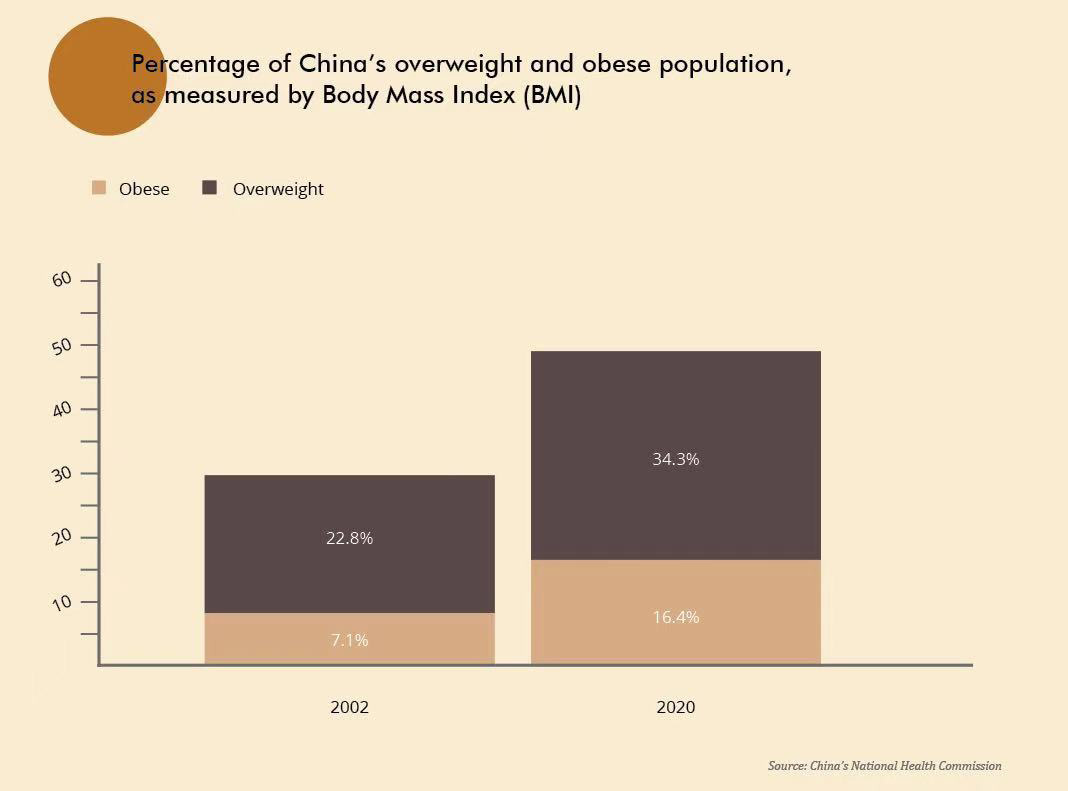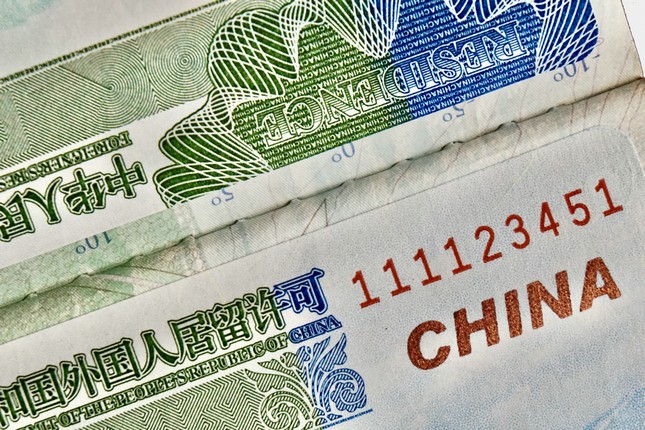In ‘Weighing In: Why Waistlines are Widening in China’s Biggest Cities,’ our February 2021 cover story, we address how China’s economic prosperity has beefed up its people and what can be done to slim it down.
Wealth and waistlines have a tendency to grow together. China’s rapidly developing economy has helped raise the standard of living to meteoric heights in recent decades. And while people in the Middle Kingdom are now wealthier, their diets have become ‘richer’ but not better. The country’s leading health authority drew attention to the elephant on the scale in a report released last December, revealing that more than half (50.7%) of Chinese adults were now overweight – a 27% increase since 2002.
Rates of overweight (34.3%) and obesity (16.4%) in Chinese adults are relatively lower than in developed Western countries. However, the rising figures and large population size raise concerns about unhealthy lifestyles and adverse effects on the national healthcare system.
Belly Boom
Data on weight in China was hard to come by until the start of Deng Xiaoping’s ‘Reform and Opening Up’ movement in 1978. “In 1980, Charlotte Ikels, a regular visitor to Guangzhou, reported that hardly anyone appeared overweight,” coauthors Paul French and Matthew Crabbe wrote in Fat China: How Expanding Waistlines are Changing a Nation (China in the 21st Century), published in 2010. “But this was about to change, and by the end of the decade, obesity would be declared a national health issue in China’s large cities.”
The country’s early comprehensive surveys on diet and nutrition were more focused on monitoring China’s malnutrition rate. The findings showed progress across the country in the decades following the Great Chinese Famine in the late 1950s – a period where millions of rural Chinese starved due to disrupted agricultural productivity and natural disasters, among other reasons. But it didn’t take long for the government to notice a growing trend in overweight citizens, especially in China’s major cities. “Back during the famine period, that generation focused on food quantity instead of food quality – the priority for them was staying alive. As famine got resolved along the way and the availability of food increased, the next generation had more choices,” says Katrin Lee, a clinical dietitian at Jiahui Health in Shanghai. “A history of famine and food shortages [dating] back to the 1950s had some impact on people’s perception towards food and food choices, which could be a factor contributing to average weight gain.”

Image via Unsplash
French and Crabbe note that the number of overweight people in China accounted for 7% of the population in 1982, a figure that would double by 1992. By the time China had completed its first comprehensive national survey on diet, nutrition and disease in 2002, 22.8% of Chinese adults were overweight and 7.1% clinically obese – a staggering rise in both categories over 20 years. China’s then Vice Minister of Health Wang Longde had sounded the alarm on the long-term impact that the growing obesity problem in urban areas could have on the nation’s healthcare system, with infectious disease rates expected to rise. In Fat China, the authors’ add that rates in hypertension, high blood pressure, arteriosclerosis (hardening of the arteries), poor blood sugar and diabetes were all on the rise in the 2000s, according to China’s Ministry of Health. “By mid-decade, things were looking increasingly worrying… it seemed clear that as the urban economy was growing, so were ‘prosperity induced’ waistlines,” wrote French and Crabbe.
“In 1980, Charlotte Ikels, a regular visitor to Guangzhou, reported that hardly anyone appeared overweight”
The World Health Organization (WHO) defines a person with a body mass index (BMI) over 25 as overweight and 30 as obese – BMI is calculated by a person’s weight in kilograms divided by their squared height in meters. However, China has set stricter standards for BMI due to differences in body composition among different ages, genders and ethnic groups. Those in China with a BMI over 24 are overweight, and 28 are obese.

The December report, titled ‘The 2020 Report on Chinese Residents’ Chronic Diseases and Nutrition,’ showed that the average weight of adult men (69.9 kilograms) and women (59 kilograms) increased by 3.4 kilograms and 1.7 kilograms, respectively, over the past five years. The alarming weight trend is even more daunting for children in China, as the report reveals that 20% of children aged 6 to 17 are obese. Zhao Wenhua, chief nutritionist with the Chinese Center for Disease Control and Prevention, cited the growing overweight/obese population in China as a byproduct of social-economic development and lifestyle and behavioral changes in recent decades.
Not Hot Pot
‘You’ve gotten fatter’ and ‘You’ve gotten thinner’ are common greetings that people hear when meeting with friends and family in China. There’s a heightened focus on weight and appearance in the Middle Kingdom that has led to online debates about the definition of fat or overweight. At the same time, social activities often involve eating and drinking, making it all the more challenging to avoid weight gain when going out for an oil-laden hot pot regularly, for instance. “Ultimately, the main reason for excess weight is excess intake or inadequate output,” says Lee. She sees increased food availability and convenient meal delivery as culprits to an unbalanced lifestyle. “Before, not as much [food] was available during certain times of the day so people may eat less,” Lee points out. Where in the past, folks would have no choice but to go to wet markets, supermarkets and shops, nowadays groceries and meals can arrive at your doorstep without having to leave the couch. Ultimately, reducing overall physical activity while still consuming the same or more calories.
It’s also the types of food that people are consuming that are at the forefront of an obesity issue in the country. “While Chinese people have always eaten staples like grain as the main food, in previous decades we consumed less meat, oil and salt,” Huang Wanting, a Guangzhou-based registered dietitian, tells That’s. Huang highlights people’s desire for ‘heavy flavors’ that smell and taste better, all while likely helping to pack on the pounds. “Youtiao (fried dough sticks), hongshaorou (braised pork with plums) and hongshao qiezi (brown braised eggplant) are very common Chinese dishes, but need to be eaten in moderation,” says Huang.
In November 2020, a man, under the pseudonym Wang, nearly died in Chengdu after suffering an aortic dissection (tear in the inner layer of the aorta) from eating hot pot and barbecue every day with his wife for three years. Local media interviewed Wang’s wife, who said their diets dramatically changed after moving to Chengdu, eating unhealthier food in excess late at night. Ouyang, the lead surgeon who operated on Wang, said that many young people have high blood pressure yet ignore the risks, as cited by Red Star News. However, the report released by the National Health Commission last December noted that Chinese residents are paying increasing attention to nutrition and chronic disease. Among residents 18 and older, nearly 60% had checked their body weight within the past month of being surveyed, and over half of adults aged 40 or older had gotten their blood pressure checked in the last three months.

Wang in a Chengdu hospital. Image via 红星新闻
The proliferation of Western fast-food chains in China is also to blame, particularly with younger generations. Kentucky Fried Chicken (KFC) was the first to set up shop in the PRC’s capital city back in 1987. KFC China would go on to create a blueprint for success by offering a wide variety of foods and traditional dishes to appeal to the local market as well as create larger outlets for customers to dine-in and hang out for an extended time. In recent years, we’ve seen KFC roll out durian chicken nuggets – a popular fruit in China – and McDonald’s launch Coca-Cola chicken wings – a version of the Chinese home-style dish. The two fast-food giants and others have found success by making these cultural changes.

McDonald’s Coca-Cola chicken wings (left) and KFC’s durian nuggets (right). Images via Jesse Pottinger for That’s, 肯德基/WeChat
READ MORE: We Tried McDonald's Coca-Cola Chicken Wings and So Should You
“The dining environment at McDonald’s is similar to a [Chinese] canteen, perhaps this is the key to their success”
On Zhihu, a question-answer platform, here’s one internet user’s take on why American fast-food chains are popular in China: “The dining environment at McDonald’s is similar to a [Chinese] canteen, perhaps this is the key to their success. Think of a Chinese restaurant, people are always staring at you… when sitting at a McDonald’s, it’s relaxing, just like in the canteen.” While Western food chains have made efforts in providing Chinese consumers with nutrition information and new healthier alternatives, their primary high-calorie, low-nutrient foods are only adding to China’s scale.

McDonald’s on Beijing’s Wangfujing Street in 1994. Image via Bruce Connolly
Another significant factor leading to weight gain is the diminishing amount of physical activity of people living in major cities. The NHC report says less than one in every four Chinese adults are exercising once per week. Lee notes that inadequate physical activity plays a significant role in weight gain in individuals, with many in cities taking on more sedentary jobs and increasing their use of electronic devices. In 2019, China Youth Daily’s survey center wenjuan.com released a survey on Chinese mobile phone usage among adults, which showed that 84.7% of respondents spend, on average, three hours each day on their phone. Unhealthy working schedules, particularly in China’s rapidly growing tech and internet sectors, are also to blame. According to the 2017 China Labor Dynamics Survey, more than 40% of respondents reported working longer than 50 hours a week, as cited by Financial Times. China labor law states workers shouldn’t work more than 44 hours a week.
With so many determinants of weight gain, it can be difficult to digest. Fortunately, a growing global human nutrition industry can help address these challenges. “As the government and people pay more and more attention to health problems, the status of nutritionists is rising,” says Lee, but expresses skepticism over the use of the term. “When searching ‘nutritionists’ in a search engine, a lot of different nutritionist certification programs show up. But few, if any, are officially recognized nutrition organizations. This implies that there are some ‘nutritionists’ in society who were not trained by official programs or proper standard knowledge.” Unlike dietitians, people in many countries can claim to be nutritionists without any official training or certification. According to Lee, the Chinese Nutrition Society has made strides in standardizing qualification and training but still requires more support from other institutions. Meanwhile, the role of dietitians in China cannot be understated, by helping to advocate for healthy eating and obesity prevention via different channels. According to China Daily, the country’s first group of registered dietitians gained their professional certifications in 2017. China needs up to four million dietitians to meet the needs in addressing health issues, according to Wang.
Keeping it Light
While the country continues to build a legion of health experts to tackle this issue, a blend of public and private initiatives in China are underway to help the country trim some fat. In 2016, President Xi Jinping announced the Healthy China (HC 2030) blueprint, a national strategy covering everything from public health services, environmental management, the Chinese medical industry and food and drug safety. In HC 2030, Beijing addresses the need to reduce ‘health life,’ referring to “premature mortality resulting from major noncommunicable diseases” by a relative 30% from 2015 to 2030. Diabetes is one of the common noncommunicable diseases affecting the country.
China also issued the National Nutrition Plan (2017-2030) the following year to improve nutritional management and monitoring and dietary guidelines, among other areas. One important aspect of the plan is to increase nutrition intake research so that the data is based on Chinese people rather than foreigners. Given the differences in BMI standards between China and Western countries, an increase in nutritional data from Chinese people may help address issues specific to the country.
China’s private sector also has an important role to play in advocating for a healthier lifestyle. With technology continually becoming an integrated part of our lives, there are new ways for it to promote healthy habits. WeChat’s Official Account for fitness, WeRun, which launched in 2015, is a simple yet powerful way to increase people’s activity awareness throughout the day by tracking steps and sharing results on a digital leaderboard. We’ve seen other forward-thinking concepts pop up in gyms across the Chinese mainland. Fitness chain Le Fit (乐刻健身), which operates gyms in all major Chinese cities, makes working out easy and motivating via its official app. Members can learn new workouts, book trainers and compare their running distances on the facilities treadmills with other gymgoers. Another benefit is the flexible membership system, where you can purchase monthly, seasonal and yearly passes, unlike traditional gyms.

Image via That’s
Perhaps the biggest success story to come out of China’s fitness industry is Tencent-backed fitness app Keep, which made waves in 2020 after becoming the country’s first sports tech startup to reach a USD1 billion valuation, raising USD80 million in series E funding in May. Technode describes Keep as a “fitness trainer in your pocket” because it offers a suite of personalized training courses for workout sessions outside the gym. And like WeRun and Le Fit, it nurtures the social aspect so users can share their workout progress.
“The concept of healthy eating is gradually being accepted by the public, and I am personally optimistic about it. At my restaurant, our guests practically all order light meals”
On the dietary front, Chinese adults have shown increasing awareness of healthier food options. Popular new food trends in China, such as plant-based meat, could help improve lives by reducing beef and pork in Chinese diets. And while meal delivery continues to be a favored dining option among folks, we’re starting to see a rising demand for ‘light meals’ (轻食) online. These meals help promote fresh vegetables and fruit, among other nutrient-rich foods instead of salt-heavy, greasy dishes. Li, the owner of Waiting Coffee, a restaurant in Guangzhou, tells us that light meals and healthier lifestyles, in general, are becoming more trendy. “The concept of healthy eating is gradually being accepted by the public, and I am personally optimistic about it. At my restaurant, our guests practically all order light meals.”

‘Qingshi.’ Image via Zhihu
Whether China’s weight problem is here to stay or go is reliant upon a dizzying number of factors. Still, with growing public awareness, the continuous rollout of measures targeting healthy lifestyle by the government and innovation in fitness and dieting from the private sector, there’s hope that the country that grew before the world’s eyes can now lead in trimming its waistline.
Additional reporting by Joshua Cawthorpe
[Cover image via Unsplash; compiled by Felix ‘Bounty Hunter’ Chan/That’s]






















0 User Comments